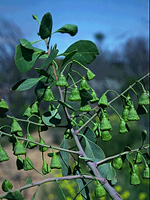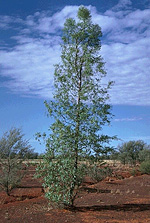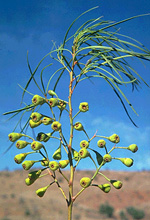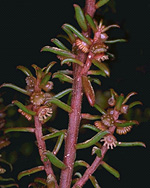 |
The family Gyrostemonaceae is endemic to Australia and occurs almost throughout the continent except the monsoonal "Top End" of the Northern Territory and south-west Tasmania. Species may be locally common, but are not often met with except in arid areas.
Characteristic features of the family Gyrostemonaceae in Australia include: - shrubs or small trees, often with somewhat succulent, rubbery stems and leaves
- flowers inconspicuous, unisexual, usually on separate plants, borne single or in racemes or spikes
- perianth 1-whorled, of 4-5 lobes surrounding a fleshy disc on which are borne the numerous stamens and carpels
- fruits usually fleshy at first, finally breaking radially into separate, 1-seeded articles (mericarps)
Description
Evergreen, or semi-deciduous trees, or shrubs, or annual or biennial terrestrial herbs. Stems unarmed or rarely with thorns or spines arising from the leaf axils. Vegetative reproduction by root suckers. Stem internodes terete or distinctly angular. Internal secretions not obvious. Plants glabrous or with simple, non-glandular, unicellular hairs. Leaves well developed or much reduced (i.e. to scales, etc), or entirely absent, alternate and spiral, cauline if herbs, petiolate, subsessile or sessile. Stipules absent, or present and distinct and free from the petiole, spine-like or bristle-like, falling off early or persistent. Lamina simple, symmetric, dorsiventral; filiform, acicular, subulate, linear, lanceolate, ovate, elliptic, oblanceolate or obovate; base cuneate, attenuate or rounded; margins entire, ±flat; one-veined, or the venation pinnate, with the midrib conspicuous or inconspicuous, and the tertiary venation not reticulate; surfaces not punctate; herbaceous, leathery or succulent. Male and female flowers mostly occurring on separate plants or sometimes on the same plant. Inflorescences terminal or axillary, consisting of spikes, racemes, panicles or solitary flowers. Bracts absent. Bracteoles present. Flowers sessile or stalked. Floral disc present or absent. Perianth regular, of 1 whorl only, with 4–5 fused sepaloid segments, imbricate in bud, bell-shaped, herbaceous, green, without contrasting markings. Fertile stamens 7–numerous, not clearly correlated with and free of the perianth segments, free of the ovary and style, distinct from each other, all ±equal. Anthers dorsifixed, not versatile, opening inwards by longitudinal slits, 2-celled. Ovary superior and sessile. Carpels 2–60, ±fused; ovary with 1–60 locules. Style terminal or eccentric, single and unbranched, branching from the base, or absent and the stigma ±sessile. Ovules1 per locule, stalked; placentation axile. Fruit a dry schizocarp; the perianth on the maturing fruit dry and persistent. Disseminule macro-surface featureless, winged or with spines; micro-surface ±smooth, spinulose or rugose, white, cream, red or brown, dull. Seeds 2–25 per fruit. Aril present. Cotyledons 2. Embryo curved.
(Note: this description has been generated from the coded data compiled for the key. Any errors in the key data will be reflected in the descriptions.)
A treatment of the family Gyrostemonaceae has been published in:
Flora of Australia 8: 362-379.
Australian genera of Gyrostemonaceae (as recognised for the Flora of Australia)
Codonocarpus
Gyrostemon
Tersonia
Walteranthus

|
  |

Codonocarpus cotinifolius (fruits)
Photo: M.Fagg © M.Fagg

Codonocarpus cotinifolius (habit)
Photo: M.Fagg © M.Fagg

Codonocarpus pyramidalis (fruits)
Photo: M.Fagg © M.Fagg

Gyrostemon australasicus (flowers)
Photo: M.Fagg © M.Fagg
|
 |
|